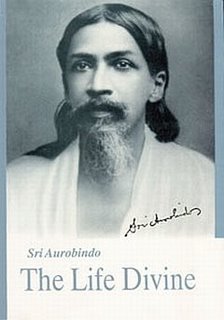 |
Supermind, Mind and the Overmind Maya
The Maya of Knowledge and The Maya of Ignorance
While the multiplicity was programmed in the Supermind from the matrix of unity, it began to be activated at the level of the Overmind. This means that an executive power facilitates the dissociation of an infinite variety of Idea-Forces from their underlying unity so as to become independent and unique. The very fact of independence and uniqueness means a cut off from the unitary source and thus implies Ignorance. In other words, the executive Power at the level of Overmind ultimately facilitates the creation of a world of Ignorance! Yet the executive power at the level of the Overmind is a power of Knowledge or in metaphysical terms a Maya of Knowledge that makes the Ignorance possible. (The Life Divine, pg.299) This higher Maya is different from the Maya of Ignorance that acts at the level of the multiplicity and makes every integer of the multiplicity to be unique and de-linked from the underlying source of unity.
|
|
To create a world of variegated multiplicity, all the integers in the manifestation must be allowed to independently develop their potentials to the extreme limit possible. This would naturally lead to conflict and disharmony. Thus the Maya of Knowledge at the level of the determinative Overmind facilitates the appearance of the Maya of Ignorance at the level of the expressive multiplicity. This was inevitable because the principle of separative individuation demanded a development of absolute potentials for each integer as the Unitary consciousness descends to manifest the world of a multiplicity. This "inevitable descent, facilis descensus, which Consciousness, once it admits the separative principle, follows till it enters by obscuring infinitesimal fragmentation, tucchyena, into the material Inconscience, -- the Inconscient ocean of the Rig Veda". (Ibid)
Yet the memory of a harmonious unitary matrix still lurks in the great Inconscience because the Superconscience itself gets hidden in the folds of Inconscience. A resurrection of the harmony is ordained but needs to be worked out through a process of an evolution of consciousness where latent powers of consciousness are sequentially released along a trajectory that takes us back to Godhead - the source of unity and harmony.
The Maya of Ignorance that allowed independent Idea-Forces to assert themselves often at the cost of one another has also its value for only when the world is saturated and satiated with the burden of multiplicity that there arises the need for harmony and a true harmony cannot be established without acknowledgment of the principle of unity which emerges slowly though an evolutionary unfolding of consciousness. "In that slow and difficult emergence a certain semblance of truth is given to the dictum of Heraclitus that War is the father of all things; for each idea, force, separate consciousness, living being by the very necessity of its ignorance enters into collision with others and tries to live and grow and fulfil itself by independent self-assertion, not by harmony with the rest of existence. Yet there is still the unknown underlying Oneness which compels us to strive slowly towards some form of harmony, of interdependence, of concording of discords, of a difficult unity". (Ibid) This harmony is achieved by an evolution of concealed superconscient powers of cosmic Truth. Sri Aurobindo assures that the higher harmony can also be realized in "the very fibre of our being". (Ibid, pg.300) But for that the overhead planes above the mind of cognition have to sequentially open up. "The higher ranges of spiritual Mind have to open upon our being and consciousness and also that which is beyond even spiritual Mind must appear in us if we are to fulfil the divine possibility of our birth into cosmic existence". (Ibid)
Date of Update:
21-May-21
- By Dr. Soumitra Basu
|

